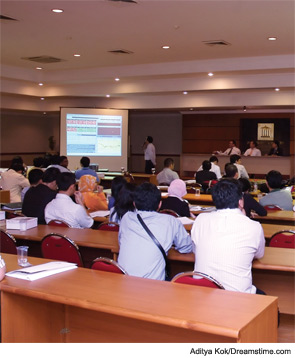Presenters should also identify two or three points they want to develop and create a strong closing, she added. “It should be something that will make people remember what you said weeks or even months later.”
Explore This Issue
April 2012Use Body Language
Having a clear message frees speakers to focus on another key aspect of effective presenting: body language.
“When you’re actually delivering your presentation, you have to remember: I really know this message, now I need to use powerful body language,” Dr. Miller said. “I need to look comfortable, maintain eye contact, stand tall, and use a voice that’s heard.”
Jannette Collins, MD, Ben Felson professor and chair of radiology and professor of medicine at the University of Cincinnati College of Medicine, who regularly gives faculty workshops on delivering effective presentations at Radiological Society of North America Annual Meetings, said she counsels physicians in her specialty to deliver in a conversational yet professional manner, varying the volume and pace of their speech. “An example I use is delivery of a paragraph that’s monotone with no change in voice inflection. I ask the person, ‘If that is not how you talk to a friend, then why would you speak that way when talking to an audience?’”
She also said speakers should move around, as opposed to being fixed at a podium, and they should make broad, open-handed gestures to the audience, being careful not to point fingers or wave their fists, which can be seen as threatening.

Get the Audience Involved
Involving the audience in your presentation is the easiest way to sustain their attention, Dr. Collins said, and there are numerous ways to make even a presentation to thousands of people interactive. “You can ask rhetorical questions, ask for a show of hands, ask members of the audience to interact with the people next to them or write down an idea,” she said. She also suggested giving clinical scenarios and asking audience members what they would recommend for further management, or even using volunteers for role playing.
When it comes to a lay audience, Dr. Hall said you should pause for questions throughout the presentation so you don’t lose their attention as time passes. Using props may also be effective for this type of listener, Dr. Miller noted. “If the presentation is about smoking, you may want to bring a pack of cigarettes,” she said, “or show a short video of a patient who’s had a laryngectomy and is speaking with an alternative method.”
Use PowerPoint, Sparingly
Rarely will a speaker give a presentation without using PowerPoint, but the program has become fatally easy, Dr. Hall said. “The problem is people try to cram too much info in too short a space of time, and you suffer from PowerPoint overload.” To prevent that from happening, he suggests having no more than one slide per minute of a presentation.
Leave a Reply